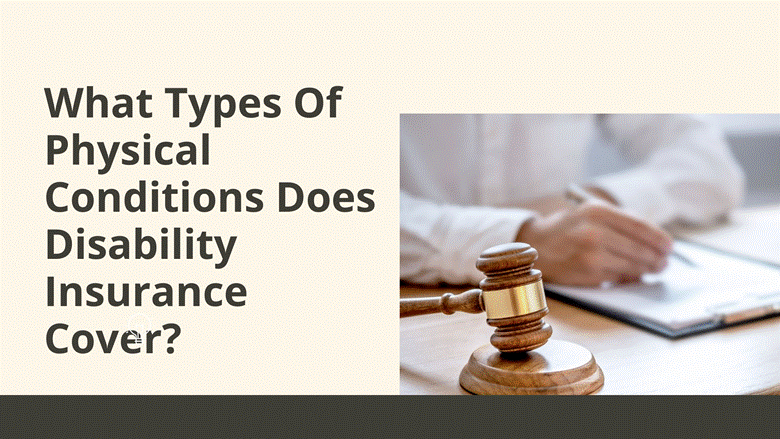
Disability insurance provides financial security when an injury or illness prevents you from working. However, not all physical conditions are treated equally under disability policies.
The coverage scope varies based on factors like policy type, benefit duration, exclusions, and more. Let’s demystify what is and isn’t covered so you can make informed decisions.
The Broad Scope of Disability Insurance
Disability insurance generally covers physical conditions that impact your ability to work in your own occupation. This includes:
- Orthopedic injuries like broken bones, torn ligaments, herniated discs.
- Cardiovascular diseases include heart attacks, strokes, and aneurysms.
- Neurological conditions like multiple sclerosis, Parkinson’s, epilepsy.
- Cancer diagnoses and treatments like chemotherapy.
- Injuries from accidents, burns, loss of limb or sight.
- Severe arthritis limiting mobility.
- Organ failure requires transplants like liver, kidney, and lungs.
Disability insurance attorneys can be valuable allies when navigating the complexities of pre-existing conditions and insurance policies.
They have expertise in interpreting insurance contracts and can help ensure you receive the coverage you’re entitled to. However, the specifics of your policy determine eligibility, especially for pre-existing conditions. Let’s unravel those intricacies.
Navigating Pre-Existing Conditions
Most policies define pre-existing conditions as those diagnosed or treated within a “look-back period” before your policy starts. Look-back periods are usually 12-24 months.
Pre-existing conditions are covered after a “waiting period” when you’ve been insured continuously. These waiting periods typically range from 6-24 months.
So if you had a heart attack 20 months before applying for disability insurance with a 12-month look-back, it would be covered after the 6-month waiting period. Read the fine print.
Key Differences: Short-Term vs. Long-Term Disability
Short-term disability provides benefits for recoverable conditions lasting less than 6 months. This covers:
- Minor injuries like sprains, fractures
- Minor surgeries like appendectomies, hernia repair
- Temporary illnesses and infections
- Maternity leave and childbirth recovery
Long-term disability protects against permanent or lasting conditions. Examples:
- Severe arthritis, chronic pain limiting mobility
- Heart disease, stroke, paralysis, blindness
- Neurodegenerative diseases like ALS, Parkinson’s
- Cancer, kidney failure requiring dialysis
Understand your needs before choosing policy duration.
Contrasting Government and Private Disability Insurance
Social Security Disability Insurance (SSDI) is a government-sponsored option with strict eligibility. Private disability insurance offers more flexibility.
With SSDI, you must be completely unable to work in any occupation and meet their definition of disability. Private insurers consider your ability to work your own job.
SSDI pays only after a 5-month waiting period. Private coverage starts within 1-2 months. Payouts are also higher under private policies.
Pay Attention to the Fine Print
Beyond pre-existing conditions, policies have other exclusions like:
- Self-inflicted injuries, drug/alcohol abuse.
- Injuries from dangerous hobbies, and illegal acts.
- Mental illness, unless a rider is purchased.
- War, terrorism, civil disobedience.
- Injuries during military service.
Disabilities during the policy’s “elimination period” may also be excluded. This period can range from 30-180 days. Read the fine print closely.
Factors Impacting Premiums and Payouts
The scope of coverage is the main determinant of premiums. Policies with shorter benefit periods or more exclusions cost less. Payout duration also affects premiums. Two-year benefits cost less than benefits payable to age 65.
Of course, the higher the monthly payout amount, the more you’ll pay in premiums. Factor in any waiting periods too.
Real-World Coverage Scenarios
- If you become paralyzed from a car accident 6 months after purchasing private disability insurance, you’ll likely receive benefits without waiting periods or exclusions.
- If you undergo hip replacement surgery for arthritis 15 months after getting coverage, pre-existing condition waiting periods would apply before payouts.
- If you suffer long-term depression and mental illness, you would only qualify for benefits if you had purchased the mental health rider with your policy.
Understanding exactly what triggers or precludes payouts based on your unique situation ensures you get the protection you need without overpaying. Consult experts and read the fine print.
While a disabling condition can derail lives, disability insurance provides financial stability when you need it most. Just be sure to pick the right policy with the appropriate coverage scope, duration, and terms to suit your needs in the event of an unfortunate illness or injury.
How to Choose the Right Disability Insurance Policy
Choosing the right disability insurance policy is a critical decision that can significantly impact your financial security in times of need. To help you make an informed choice, consider the following factors:
Factors to Consider When Selecting Disability Insurance
- Coverage Scope: Determine what types of disabilities the policy covers. Does it include both short-term and long-term disabilities and partial or total disabilities?
- Elimination Period: Understand the waiting period, known as the elimination period, before benefits kick in. Shorter elimination periods mean quicker access to benefits.
- Benefit Amount: Evaluate how much of your income the policy will replace if you become disabled. Typically, policies replace 50-70% of your pre-disability income.
- Benefit Duration: Consider the length of time the policy will pay benefits. Some policies provide benefits until retirement age, while others are shorter.
- Premium Costs: Determine how much you’re willing to pay in premiums. Be cautious of policies with low premiums but limited coverage.
Tips for Evaluating Policy Options
- Read the Fine Print: Carefully review the policy documents, paying attention to exclusions, limitations, and definitions. Ensure the policy aligns with your specific needs.
- Consider Policy Riders: Explore optional riders that can customize your coverage, such as cost-of-living adjustments or residual disability riders.
- Compare Multiple Quotes: Obtain quotes from different insurance providers and compare their offerings to find the best balance between cost and coverage.
Working with an Insurance Agent or Broker
- Expert Guidance: Insurance agents or brokers can provide valuable insights and guidance, helping you navigate the complexities of disability insurance.
- Access to Multiple Providers: Brokers can offer policies from various insurance companies, expanding your options and increasing the chances of finding a policy that suits you.
- Assistance in Claims: In case of a disability, agents and brokers can assist you in filing and managing your claims, ensuring a smoother process during a challenging time.
Disability Insurance Resources and Support
When dealing with disability insurance, knowing where to turn for support and assistance is essential. Here are some valuable resources available to you:
Organizations and Associations
- National Association of Insurance Commissioners (NAIC): NAIC provides consumer resources and can help you understand insurance regulations in your state.
- American Council of Life Insurers (ACLI): ACLI offers insights and information on disability insurance and related topics.
- National Organization of Social Security Claimants’ Representatives (NOSSCR): If you’re navigating Social Security Disability Insurance (SSDI), NOSSCR can provide valuable resources.
Legal and Financial Assistance
- Legal Aid Organizations: Many legal aid organizations offer assistance in understanding and pursuing disability insurance claims, particularly if you face legal challenges.
- Financial Planners: Certified financial planners can help you manage your finances during periods of disability, ensuring you make informed decisions.
Navigating the Disability Insurance Landscape
- State Insurance Departments: Contact your state’s insurance department for insurance regulations and consumer protection information.
- Online Forums and Communities: Join online communities where individuals share their experiences with disability insurance, providing insights and support.
These resources can empower you to make informed decisions, access support when needed, and navigate the complexities of disability insurance effectively.
Frequently Asked Questions
Is pregnancy covered under disability insurance?
Typical policies don’t consider pregnancy a disability. Some offer maternity leave coverage through riders. Costs and waiting periods apply. Check policy terms.
What if my condition is excluded from coverage?
Exclusions don’t necessarily prohibit approval. With adequate medical evidence and documentation, you can appeal denials. Consult your insurer.
Can I get disability insurance if I have a pre-existing condition?
Yes, but coverage for that specific condition will only start after the designated waiting period. Look for policies with shorter look-back and waiting periods.
Key Takeaway
Don’t wait until something happens to understand your disability coverage. Study the limitations and align them with your risks and needs today.







